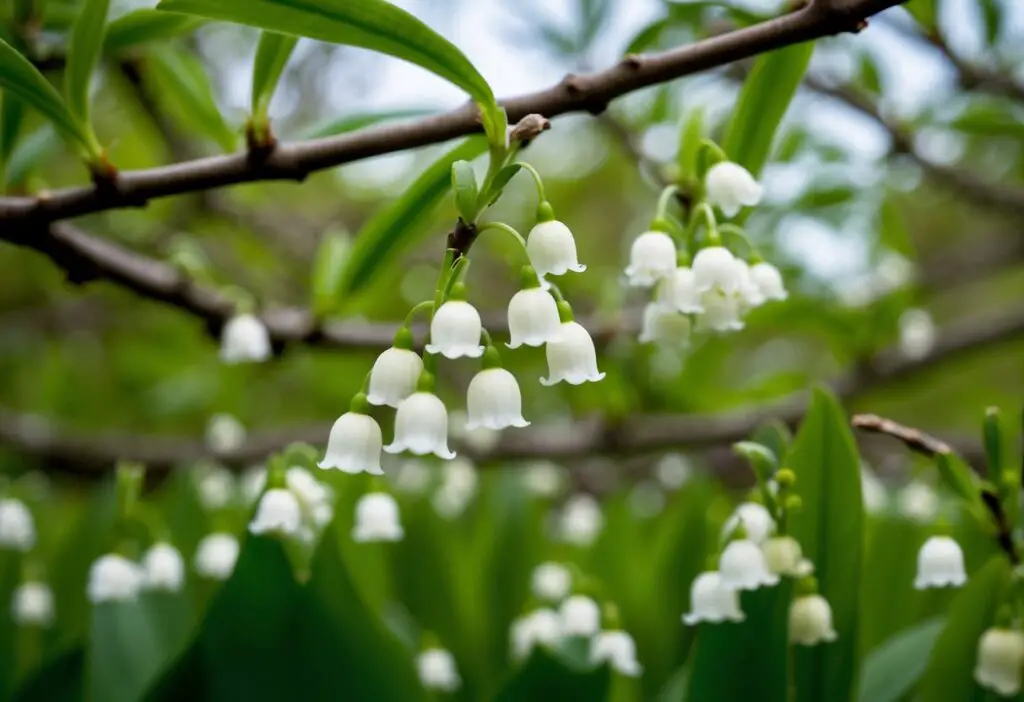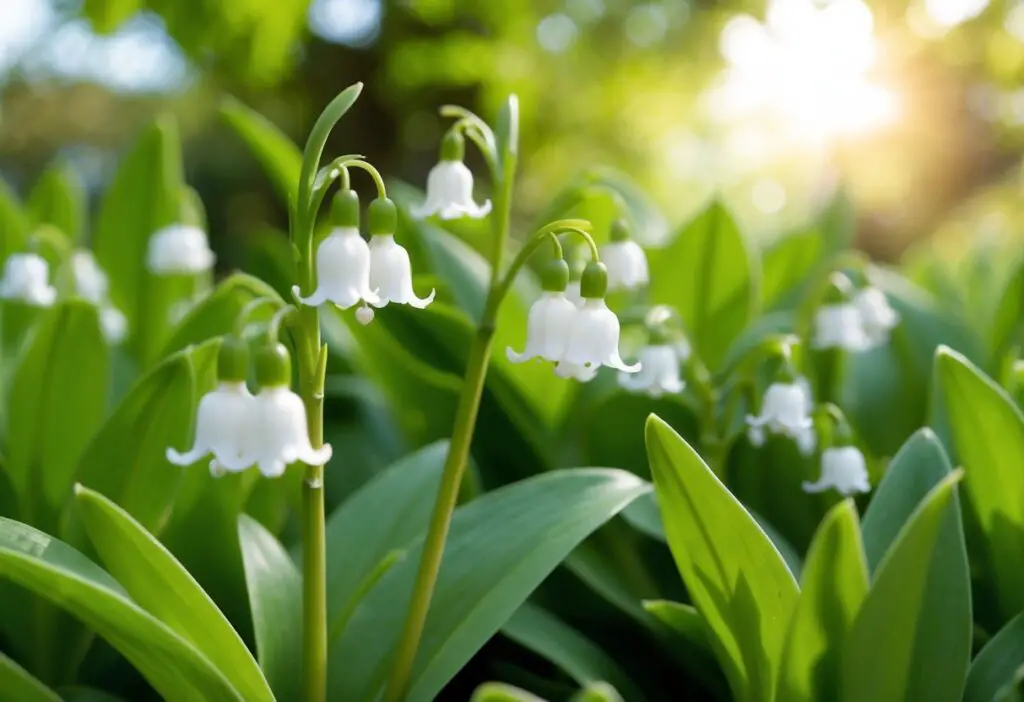Imagine strolling through a garden in May, surrounded by the gentle fragrance of Lily of the Valley and the vibrant blossoms of Hawthorn. These two flowers, celebrated as May birth flowers, carry deep meanings and traditions. Lily of the Valley, with its small, bell-shaped blooms, represents sweetness and purity. The plant’s delicate nature can make you think of gentle spring mornings.

On your way to discovering the Hawthorn, you’ll find it standing for hope and protection. Its bright flowers in white, red, or pink clusters bring life to any landscape, reinforcing positive vibes. Whether you’re celebrating your birthday in May or just a flower enthusiast, there’s a lot to explore about these symbolic blooms.
Dive into the world of May birth flowers and uncover their secrets. Whether it’s the return to happiness promised by Lily of the Valley or the good luck associated with Hawthorn, these flowers offer a language of their own. Enjoy the journey and let these meaningful blooms inspire you!
History and Symbolism
Did you know that the flowers for May carry deep meanings and interesting stories? The Lily of the Valley is linked to tales of happiness and purity, while the Hawthorn is seen as a beacon of hope and protection throughout history.
Lily of the Valley in Myth and Lore
In Greek mythology, the Lily of the Valley is said to have grown from the tears of the goddess Maia, adding a divine touch to its beauty. This delicate flower is not just pretty but also full of symbolism. Christian lore paints it as a symbol of purity and innocence. It’s often associated with the Virgin Mary, representing humility and sweetness.
This flower is also celebrated in France during La Fête Du Muguet on May 1st, where it’s given as a token of luck. So, when you see these little white bells, remember they’re more than just a flower—they’re a piece of history that whispers stories of grace and new beginnings.
Hawthorn’s Cultural Significance
Hawthorn is another May bloom with deep roots in folklore and tradition. It’s often linked to hope and good fortune. In Celtic folklore, Hawthorn is believed to have magical properties and is associated with fairies. People would plant it near their homes for protection and to bring happiness.
In Christian symbols, the Hawthorn is sometimes seen as a symbol of Christ’s crown of thorns, adding a layer of resilience and endurance to its meaning. Hawthorn’s vibrant blossoms, whether white, pink, or red, make it a favorite for May Day festivals, signaling the triumph of spring over winter. This humble shrub carries a rich history that’s as varied as its colorful flowers.
Botanical Profiles

In May, the Lily of the Valley and Hawthorn take center stage, each boasting unique characteristics. These plants are not just about their looks. They represent strength, purity, and endurance and are tailor-suited to May’s climate.
Examining Convallaria Majalis
The Lily of the Valley, also known as Convallaria Majalis, is a beloved perennial plant known for its sweet fragrance. It sports delicate, bell-shaped white flowers that symbolize purity and sweetness. If you’ve ever tried to grow them, you know they spread quickly under the right conditions.
Sunlight: Partial shade is best for these beauties. They love a cool, shaded spot but will bloom well even under limited sunlight.
Soil: Rich, moist, and well-draining soil is essential for optimal growth. Add some organic material, and they will thrive!
Watering: These plants prefer consistent moisture, so keep the soil evenly damp—just don’t drench them!
Want to see them grow in your garden? They don’t require much fertilizer. A standard compost or balanced general-purpose fertilizer in the spring should work just fine.
Discovering Crataegus
Crataegus, or Hawthorn, is a deciduous shrub that knows how to stand its ground. Its clusters of flowers can be white, pink, or red, adding a splash of color to any landscape.
Sunlight: Full sun to partial shade works best for Hawthorn. They’re pretty flexible!
Soil: Well-draining soil is important. Though they’re not too picky, avoid soggy ground.
Watering: Moderate watering keeps them happy. Watch out for overly dry conditions.
These resilient shrubs are often grown as hedges or ornamental trees. They bring hope and good luck, fitting symbols for the month of May. Interested in adding one to your garden? It may just become your favorite plant with that easy care routine.
Cultivation and Care

Growing Lily of the Valley and Hawthorn involves understanding their unique needs. Focus on how to provide the best environment, how to propagate them effectively, and how to protect them from pests and diseases.
Ideal Growing Conditions
Lily of the Valley:
- Thrives in partial to full shade.
- Prefers cool climates and shaded areas with dappled sunlight.
- Requires well-draining, moist soil.
Hawthorn:
- Enjoys full sun to partial shade.
- Tolerates a variety of soil types, but well-drained soil is best.
- Ideal for regions with temperate climates.
For both plants, consider mulching to retain moisture and regulate temperature. This helps keep roots happy and healthy. Regular pruning is essential, especially for Hawthorn, to maintain shape and encourage blooms.
Propagation Techniques
When it comes to growing more of these lovely plants, you have a few options. For Lily of the Valley, try division in early spring or late fall. Simply dig up a clump and split it into smaller sections.
Hawthorn can be propagated through seeds, though it requires patience. Plant them in the fall after soaking and cold stratification. Alternatively, use cuttings during summer for a faster method.
Choose the right technique based on your garden’s conditions and your patience level!
Managing Pests and Diseases
Both plants are fairly resilient, but some pests and diseases can pop up. For the Lily of the Valley, watch out for leaf spot and rust. Maintaining good air circulation helps prevent these. If problems arise, remove affected leaves to halt the spread.
For Hawthorn, aphids can be a common foe. Introducing natural predators like ladybugs helps, and if necessary, use insecticidal soap. Disease management includes preventing fire blight, which involves pruning infected branches and disinfecting tools between cuts.
Seasonal Maintenance
Regular maintenance keeps your blooms thriving. In spring, focus on pruning and fertilizing to give your plants a strong start. Summer requires good watering practices, especially during dry spells, to ensure the soil doesn’t dry out.
As fall approaches, prep for winter. Trim back expired blooms and apply a layer of mulch to shield the roots from the cold. For both plants, winter care involves ensuring they are shielded from intense frosts, especially in exposed gardens.
Medicinal Uses and Folk Medicine
May’s birth flowers, Lily of the Valley and Hawthorn, have a rich history in medicine and traditional remedies. Both plants have been appreciated for their medicinal properties and herbal remedies, each offering unique benefits. In this section, you’ll learn about how these flowers have been used in traditional medicine.
Traditional Remedies with Lily of the Valley
Lily of the Valley is not just a pretty flower. It’s been a star in herbal remedies for ages! This plant has compounds that were traditionally used to help with heart problems. Think of it like a gentle helper for the heart, as people believed it could strengthen and make the heart work better.
But that’s not all. It was also used to treat epilepsy in the past, although it’s not commonly used for this purpose today. People believed in the plant’s power to calm the nerves and balance the body’s rhythm.
Nowadays, you’ll often find Lily of the Valley in certain heart-related medications, though its use is controlled due to potential toxicity.
Healing Properties of Hawthorn
Hawthorn, often known as the “heart herb,” is a favorite in traditional medicine. It shines brightest when it comes to heart health. Studies have shown that Hawthorn may improve cardiovascular function and blood circulation.
But wait, there’s more! Historically, it has been used to address digestive problems and anxiety. People believed it helped improve digestive health and had a calming effect on the mind.
While not as common today, some still turn to Hawthorn as a herbal remedy, especially for heart health. Always remember to use it under professional guidance due to its potent nature.
Personal and Gift Symbolism
May birth flowers, Lily of the Valley and Hawthorn, hold great personal and gift symbolism. They represent feelings and sentiments that are special for birthdays and other meaningful occasions. Each flower carries unique meanings, making them perfect choices for gifts.
Lily of the Valley in Personal Moments
Lily of the Valley often signifies purity and sweetness. It’s a popular choice for bridal bouquets, symbolizing a fresh start in marriage. Imagine walking down the aisle surrounded by these delicate blooms. These flowers also appear in wedding bouquets due to their timeless grace and good luck symbolism.
When choosing a gift, Lily of the Valley can express heartfelt emotions. It’s ideal for personal moments such as anniversaries and birthdays. As a birth flower gift idea, a bouquet featuring Lily of the Valley speaks volumes about sincerity and care. It’s a wonderful way to celebrate May birthdays.
The Gift of Hawthorn
Hawthorn conveys happiness and hope and is often associated with protection and good fortune. This makes it a great choice for those you wish to keep safe and joyful. Hawthorn’s arrangement is a thoughtful gift, perfect for new beginnings or to wish luck.
In gifting, Hawthorn can also represent a connection to ancient wisdom as it has a rich history in folklore. If you’re looking for something unique, consider a gift that includes Hawthorn as a symbolic gesture of good will and friendship. It’s a meaningful way to share positivity with someone special.
Hawthorn’s Representations
Hawthorn is another flower that blooms in May. This one is all about strength and protection. In many traditions, hawthorn is thought to guard against evil spirits. That’s some serious flower power!
Its blooms, sometimes red or pink, are seen as a sign of love and luck. People used to hang hawthorn in their homes to invite good fortune. Fun fact: It’s even said to bring about a sense of unity and community. Perfect for those cozy neighborhood gatherings in spring. Who knew a flower could bring folks together like that? So, when you’re out celebrating in May, remember the enchanting meanings behind these flowers.
Floral Design and Fragrance
May’s birth flowers, Lily of the Valley and Hawthorn, offer a delightful blend of sweet fragrance and visual charm. Their rich scents and beautiful blooms make them popular choices for crafting elegant floral designs.
Crafting with May Birth Flowers
When you’re thinking about floral design, Lily of the Valley dazzles with its tiny, white bell-shaped flowers. These blooms spill elegance and purity. Use them in bridal bouquets for that classic touch of sweetness.
Hawthorn, on the other hand, can be shaped into blooming hedges. Its red, pink, and white flowers bring color to arrangements. Imagine these as centerpieces for a spring event! Whether a single Hawthorn branch or an elaborate Lily design, these flowers add charm and refinement.
The Scent of Tradition and Freshness
Lily of the Valley is famed for its sweet fragrance. It’s a popular note in perfumes that require delicate scents. Ever wondered why it symbolizes happiness? Its smell can brighten any space, reminding one of spring’s fresh start.
Hawthorn might not be as famous for its scent, but its soft aroma complements the stronger Lily fragrance. Together, they create a unique olfactory experience. Whether it’s in gardens or perfumes, the scent blend offers traditional beauty mixed with fresh appeal.
Embrace these scents to infuse life into your scent designs or event spaces.
Frequently Asked Questions
May birth flowers, Lily of the Valley and Hawthorn, hold special meanings for those born in that month. They both come with fascinating symbolism and traditions. If you’re thinking about getting a tattoo or are curious about the history behind these blooms, read on to find out more.
What are the symbolic meanings behind the lily of the valley and hawthorn as May birth flowers?
Lily of the Valley signifies sweetness, purity, and a return to happiness. Its delicate bell-shaped flowers are loved for their beauty and fragrance. Meanwhile, Hawthorn, with its small clusters of blooms, symbolizes hope, happiness, and protection.
Can you suggest some tattoo designs that incorporate the May birth flowers, lily of the valley and hawthorn?
Consider a design featuring the arching stems of the Lily of the Valley with its bell-shaped blooms. You could add hawthorn blossoms intertwined or as separate clusters. Adding color can make the design more lifelike, or keep it simple with black ink for a classic look.
Is there a specific reason why May has two different birth flowers?
Having two flowers allows for more variety and richness in symbolism. Lily of the Valley and Hawthorn both offer unique traits and meanings that complement each other. This provides individuals with different options to connect with their birth month in a personal way.
How can I best represent the lily of the valley in a tattoo to signify my May birthday?
You might choose a simple stem with a few bell-shaped flowers. For something more detailed, include leaves or a shaded background. Symbolizing purity and happiness can be a personal reminder of what you value in life.
What is the significance of the hawthorn flower for those born in May?
Hawthorn is often associated with protection and happiness. It has a rich history tied to various traditions and myths. For May-born individuals, it symbolizes a life full of joy and safeguarded by positivity.
Are there any unique traditions or stories associated with the May birth flowers?
Lily of the Valley is known as May Bells and often appears in legends about renewal and hope. Hawthorn has been a part of folklore, symbolizing protection and fertility.
